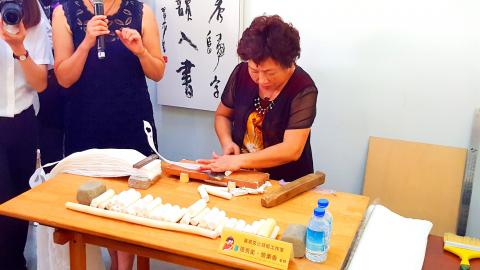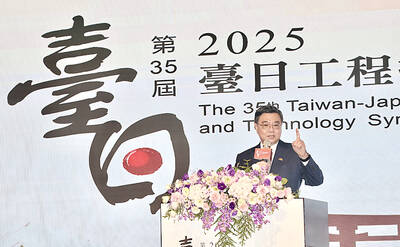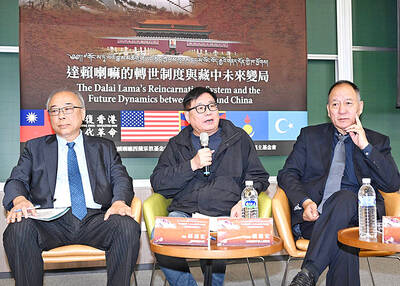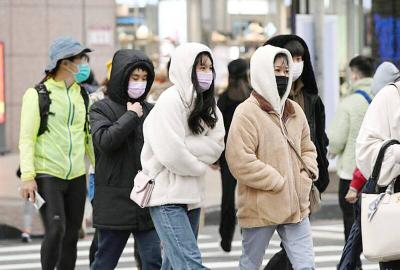Chang Hsiu-mei (張秀美) and Tseng Su-hsiang (曾素香), who witnessed the rise and fall of the pith paper industry in Hsinchu County, have opened a studio to preserve the art of making pith paper.
Pith paper, also known as rice paper, is made from the pith of the Tetrapanax papyrifer plant or the “rice paper plant.”
To turn the plant — tongcao (蓪草) or tongtuomu (通脫木) in Chinese — into handmade paper, the pure white pith of the stem must be first removed using a tube, said Tseng, 75, who began working at the Chang family’s factory when she was 15 and has 60 years of experience making pith paper.

Photo: Tsai Chang-sheng, Taipei Times
“Then, you shave the pith segment into a thin, continuous sheet using a special knife that weighs about 1kg,” Tseng said.
“The key to making an even sheet of pith paper is exerting equal pressure when you are handling the knife and slightly adjusting the amount of pressure for various pith segments,” Tseng said.
The fit of the knife and the base placed under the pith is very important, which is why each person in the factory had their own set of tools, she said.
Due to the malleability of pith paper after it is soaked in water, it is often used to make handcrafted products, she said.
Sturdier piths can even be used to make fishing floats, Tseng added.
As the pith paper industry declined, most of the workers at the factory — some of whom she has remained in contact with — found new jobs, Tseng said.
Once called the pride of the county, the craft is now at risk of disappearing completely.
Today, it is estimated that fewer than 10 people nationwide know how to make pith paper.
During the 1960s, Hsinchu County produced 95 percent of the nation’s pith paper, said Chang Hsiu-mei, who was born in 1960 and grew up during the industry’s heyday.
At the time, about one in eight people in Hsinchu County was involved in the process of making pith paper, she said, adding that sheets of paper, artificial flowers, and drawings and paintings created using pith paper were widely exported.
Although Chang does not know how to make pith paper, she spent time in a relative’s pith paper factory as a child.
She helped out at the factory and followed her mother up to the mountains to purchase the plant from Aborigines, she said.
Sometimes, she was assigned the task of cutting the plant into smaller segments, Chang said.
When the business was at its peak, there were several hundred thousand sheets of pith paper at the factory at any given time waiting to be exported, she said.
Aborigines in Hsinchu’s Wufeng (五峰) and Jianshih (尖石) townships and other mountainous regions competed to grow Tetrapanax papyrifer in large quantities, Chang said.
However, as plastic and paper made from plant fibers became more common, they gradually replaced sheets of paper and artificial flowers made from pith paper, she added.
Today, pith paper has virtually disappeared and few people even know it exists, she said.
Chang said she hopes that by opening the studio, she and Tseng can prevent the nation’s traditional craft from being forgotten.

ALIGNED THINKING: Taiwan and Japan have a mutual interest in trade, culture and engineering, and can work together for stability, Cho Jung-tai said Taiwan and Japan are two like-minded countries willing to work together to form a “safety barrier” in the Indo-Pacific region, Premier Cho Jung-tai (卓榮泰) yesterday said at the opening ceremony of the 35th Taiwan-Japan Modern Engineering and Technology Symposium in Taipei. Taiwan and Japan are close geographically and closer emotionally, he added. Citing the overflowing of a barrier lake in the Mataian River (馬太鞍溪) in September, Cho said the submersible water level sensors given by Japan during the disaster helped Taiwan monitor the lake’s water levels more accurately. Japan also provided a lot of vaccines early in the outbreak of the COVID-19 pandemic,

Kaohsiung Mayor Chen Chi-mai (陳其邁) on Monday announced light shows and themed traffic lights to welcome fans of South Korean pop group Twice to the port city. The group is to play Kaohsiung on Saturday as part of its “This Is For” world tour. It would be the group’s first performance in Taiwan since its debut 10 years ago. The all-female group consists of five South Koreans, three Japanese and Tainan’s Chou Tzu-yu (周子瑜), the first Taiwan-born and raised member of a South Korean girl group. To promote the group’s arrival, the city has been holding a series of events, including a pop-up

TEMPORAL/SPIRITUAL: Beijing’s claim that the next Buddhist leader must come from China is a heavy-handed political maneuver that will fall flat-faced, experts said China’s requirement that the Dalai Lama’s reincarnation to be born in China and approved by Beijing has drawn criticism, with experts at a forum in Taipei yesterday saying that if Beijing were to put forth its own Dalai Lama, the person would not be recognized by the Tibetan Buddhist community. The experts made a remarks at the two-day forum hosted by the Tibet Religious Foundation of His Holiness the Dalai Lama titled: “The Snow Land Forum: Finding Common Ground on Tibet.” China says it has the right to determine the Dalai Lama’s reincarnation, as it claims sovereignty over Tibet since ancient times,

Temperatures in some parts of Taiwan are expected to fall sharply to lows of 15°C later this week as seasonal northeasterly winds strengthen, the Central Weather Administration (CWA) said today. It is to be the strongest cold wave to affect northern Taiwan this autumn, while Chiayi County in the southwest and some parts of central Taiwan are likely to also see lower temperatures due to radiational cooling, which occurs under conditions of clear skies, light winds and dry weather, the CWA said. Across Taiwan, temperatures are to fall gradually this week, dropping to 15°C to 16°C in the early hours of Wednesday